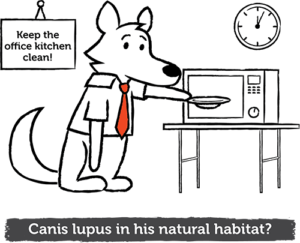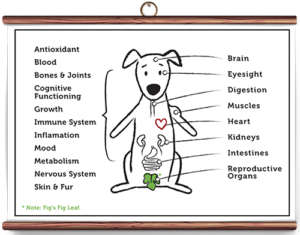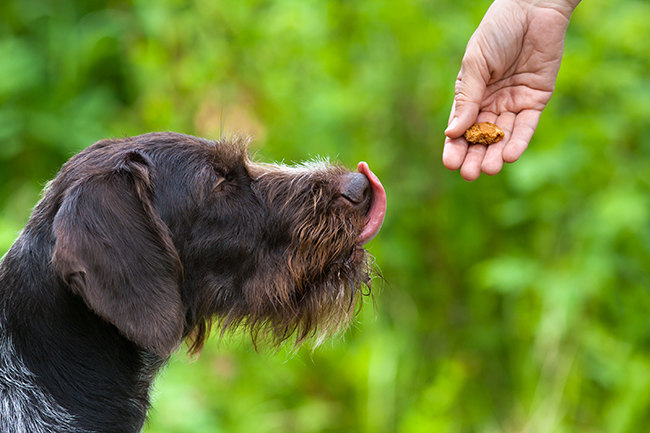By the Fig & Tyler Staff
 You are an expert when it comes to training or grooming, which likely means you’re very knowledgeable when it comes to dog and cat treats.
You are an expert when it comes to training or grooming, which likely means you’re very knowledgeable when it comes to dog and cat treats.
However, your clients may not be as well-informed. What follows are some key points you might find useful to help your clients understand the differences between treats and their usage.
“Treat” Can Be a Loaded Word
You might have found that some people have a negative reaction to the word “treat.” In the human-world this term typically implies something unhealthy.
As a pet professional, you can use these moments as an opportunity to explain to your clients that in the dog and cat world, “treat” doesn’t necessarily refer to something unhealthy. Instead, it can refer to a nutrient-rich morsel of food that will capture a dog or cat’s attention and keep them focused.
We appreciate the complexity of these semantics. While Fig & Tyler is a treat company, even we aren’t always a fan of the word “treat.” We use it because it’s the clearest way to describe our products. We would love to say we sell tantalizing small morsels of food across a wide variety of proteins, but that’s quite the mouthful!
The Training Treat Hierarchy
If you are a trainer, you’re very familiar with the high-value/low-value hierarchy of treats. You also know the most high-value treat of all is the one that works with the dog or cat you are training. What is high-value to one furry student may not be high-value to another.
However, not all pet owners know this. Since we love talking about treats, we’ve outlined the basics of the hierarchy below.
- Low-value: A good example of a low-value treat is whatever a dog or cat normally eats for dinner (i.e. kibble). These treats won’t motivate as well as ones that are tastier, smellier, or new for that particular dog or cat. Over time, the trainee may lose interest in these low-value bites, or it may get harder to get their attention with these treats.
- Medium-value: Medium-value treats are snacks dogs or cats don’t usually get to eat. These motivators are different from their everyday kibble and can often be just the incentive they need.
- High-value: These are treats the dogs or cats you’re training will do anything to get. They’re great attention-getters and motivators during a session, even when there are distractions. These treats need to be exciting and special for the trainee. They typically smell and taste amazing or they are made of ingredients or novel proteins that the dog or cat does not often get. Raw, freeze-dried 100 percent meat or fish treats, like the ones we make at Fig & Tyler, fit the bill.
 High-Value Raw, Freeze-Dried Treats
High-Value Raw, Freeze-Dried Treats
Dogs are the direct descendants of wolves, which means they love raw meat. Their stomachs have the necessary acids to break down this type of protein—not to mention harder materials like bone. Cats, on the other hand, are obligatory carnivores so their instincts are hardwired to want fresh meat and fish.
Clients also might not understand the difference between freeze-dried and dehydrated treats. More than just a method of preserving astronaut food, freeze-drying is an awesome way to lock in nutrients and flavor of raw meat and fish. Freeze-drying uses a special high-pressure vacuum to remove liquid content from meat and fish, locking in all the nutritious enzymes, vitamins, and minerals. Dehydration uses heat in the process which can kill the nutrients. But, freeze-drying preserves all of the nutrients and, by removing water, it eliminates the potential for bacteria growth. This process also makes these treats shelf stable for over a year if properly stored in a cool, dry environment.
Many pet owners ask if they can feed these types of treats to their dog or cat if they are not on a raw diet and the answer is “Yes.” Raw, freeze-dried treats can be used to train dogs and cats, or keep their attention while being groomed, no matter what diet they’re on. However, you should always be sure to ask if the pet has any known allergies before introducing any type of new food or treat. Also, we suggest that people start off in moderation if their furry friend is not already on a raw diet. Most of these types of meat and fish treats are high in protein and consuming too many of them may initially result in an upset stomach.
 Yuck, Liver!
Yuck, Liver!
Pet ovners often project their own taste preferences on their dogs and cats, but animals have their own. So, while organ meat like liver or heart may not be the first thing to come to mind when preparing dinner for ourselves, these meats are delicacies for our pets. Remind your clients that organ meats and other products that they wouldn’t necessarily eat themselves are loaded with nutrients and great for their pets’ health.
Who We Are
Fig & Tyler offers one of the widest varieties of single-ingredient raw, freeze-dried morsels made from USDA-inspected meat and fresh fish. (Notice how we didn’t say “treats?”) We have something for even the pickiest pooch or those with dietary restrictions. To learn more about our offering, check us out at www.figandtyler.com. We offer pet professionals, such as yourself, discounts and many other amazing perks through our free Pet Pro Program. To join this program or learn more about it, please visit www.figandtyler.com/pages/petpros






